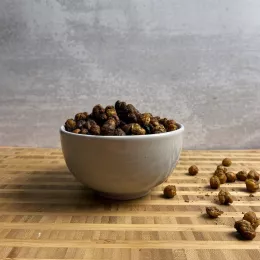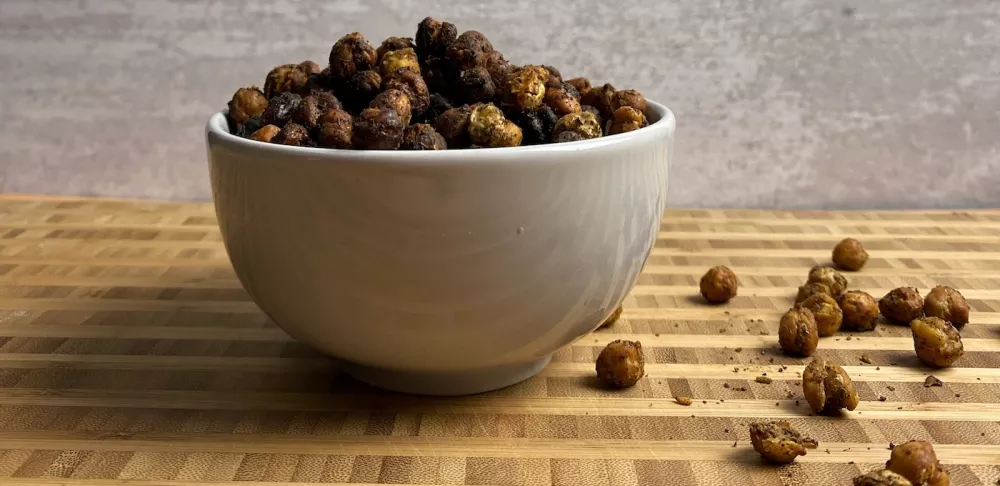Chickpeas, also known as garbanzo beans, are legumes with a unique shape. They have a delicious nut-like flavor and a texture that is buttery while slightly starchy, a versatility that makes the plant protein ideal in a variety of dishes, including two legume recipes.
Are Chickpeas and Garbanzo Beans the Same?
Yes, the seeds are often seen in Indian and Middle Eastern cuisine, such as curry, hummus and falafel. Though most are accustomed to seeing chickpeas in a tan or beige color, there are red, green, black and brown varieties available.
Nutrient-dense chickpeas are a very good source of complex carbohydrates, dietary fiber, folic acid and manganese. They are also a good source of plant-based protein, iron, magnesium, copper and zinc. Garbanzo beans contain molybdenum, a trace mineral that helps the body detoxify sulfites, a preservative commonly found in wine and deli meats.
Carbohydrates, in addition to protein and fat, are the macronutrients we need to fuel our bodies. Carbohydrates are our main source of energy, and complex carbohydrates are made up of sugar molecules that are strung together in long chains. Their complex structure and high dietary fiber content mean they take longer to break down in the digestive tract, promoting steady blood sugar levels and keeping us full and satiated longer.
How to Store Chickpeas
Dried chickpeas can be found in bulk bins and packaged varieties. Store them in an airtight container and keep them in a cool, dry place; they should last up to one year. Canned chickpeas can be found in low or no-sodium varieties and also stay at least one year in the pantry. To get rid of sodium, they should be drained and rinsed before using. Once cooked, chickpeas can be stored in the refrigerator for up to five days in an airtight container or frozen in a resealable freezer bag for up to six months.
Chickpea flour is also available, but it is best to buy a version that is made from milled cooked beans. If the flour is made from milled raw beans, this may be more difficult to digest and create issues when eaten. Many grocery stores carry chickpea flour in the gluten-free area, but if you cannot find it there, it is also readily available online.
Aquafaba is another derivative of chickpeas that is becoming popular, especially among vegans. This is the leftover liquid from cooked chickpeas, either from a can or the reserved cooking liquid when you cook dried chickpeas. It is whipped and used as a replacement for egg whites in a variety of recipes, including baked goods and vegan mayonnaise (a butter alternative).
How to Prepare Dried Garbanzo Beans
Dried garbanzo beans or chickpeas should be picked through and rinsed. Depending on the cooking method, it is recommended to first soak them in water for at least four hours or overnight, typically in the refrigerator. Soaking is not required, but it dramatically cuts the cooking time.
To cook stovetop, drain and rinse soaked beans and place in a pot with water. The ratio of three to four cups of water per one cup of chickpeas works well. Bring to a boil then lower to a simmer and cook, approximately two hours for soaked beans and three hours for unsoaked beans, until cooked through but not mushy.
Chickpeas can also be cooked in a pressure cooker, which takes less time than the stovetop version. Soaked chickpeas can often be cooked in 10 minutes in an electric pressure cooker, but refer to your appliance’s guide for details on your specific cooker.
Food Trends 2021
Chickpeas have become very popular over the last year and will continue that path throughout 2021 and beyond. They’re popping up in a range of products on grocery store shelves nationwide – and not just hummus: chickpea cereal, chickpea tofu and chickpea tortillas are available. Keep an eye out for classic comfort foods, from chips to ice cream to pasta, that contain chickpeas as a major ingredient.
Cooking with Chickpeas
Chickpeas are a great addition to many dishes and can be used in a variety of ways, such as pureed for hummus, in a stew or chili, or as part of a salad. Here are two other ways I like to use chickpeas for a twist on the usual, both from my cookbook, "The Mediterranean DASH Diet."

Farinata
Yields 6 servings
Farinata is an Italian crepe, a sort of thin, crispy-edged pancake made from chickpea flour.

Ingredients
- 2 cups cold water
- 1 cup chickpea flour
- 1⁄2 teaspoon kosher salt
- 1⁄4 teaspoon freshly ground
- Black pepper
- 3 1⁄2 tablespoons extra-virgin olive oil, divided
- 1⁄2 onion, julienned
- 1⁄2 cup fresh herbs, chopped (thyme, sage and rosemary are all nice on their own or as a mix)
Directions
- In a large bowl, whisk together the water, flour, salt and black pepper. Add 2 tablespoons of the olive oil and whisk. Let the batter sit at room temperature for at least 30 minutes.
- Preheat the oven to 450 F. Place a 12-inch cast-iron pan or oven-safe skillet in the oven to warm as the oven comes to temperature.
- Remove the hot pan from the oven carefully, add 1⁄2 tablespoon of olive oil and 1/3 of the onion, stir, and place the pan back in the oven. Cook, stirring occasionally until the onions are golden brown, 5 to 8 minutes.
- Remove the pan from the oven and pour in 1/3 of the batter (about 1 cup), sprinkle with 1/3 of the herbs, and put it back in the oven. Bake for 10 minutes, or until firm and the edges are set.
- Repeat with remaining ingredients.
Recipe
Roasted Za’atar Chickpeas
Yields 8 servings
Roasting chickpeas transforms the texture, changing the entire structure of the bean. These crunchy, fiber-rich chickpeas are perfect for a snack, party appetizer, or as topping on a salad. This simple recipe uses za’atar as the main spice, but you can try other spices or whatever you have on hand. For a spicier mix, try a little cayenne pepper. Dried sage adds a touch of herby sweetness. For smokiness, add a dash of smoked paprika.
Ingredients
- 3 tablespoons za’atar
- 2 tablespoons extra virgin olive oil
- 1⁄2 teaspoon kosher salt
- 1⁄4 teaspoon black pepper, freshly ground
- 4 cups cooked chickpeas, or 2 (15-ounce) cans, drained and rinsed
Directions
- Preheat the oven to 400 F. Line a baking sheet with foil or parchment paper.
- In a large bowl, combine the za’atar, olive oil, salt and black pepper. Add the chickpeas and mix thoroughly.
- Spread the chickpeas in a single layer on the prepared baking sheet. Bake for 45 to 60 minutes, or until golden brown and crispy. Cool and store in an airtight container at room temperature for up to 1 week.
Explore more plant protein in ICE's Health-Supportive Culinary Arts program.




